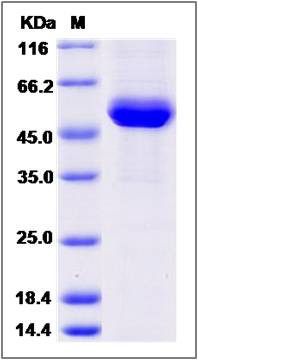Rhesus CD4 Protein (His Tag)
CD4
- 100ug (NPP2917) Please inquiry
| Catalog Number | P90274-C08H |
|---|---|
| Organism Species | Rhesus |
| Host | Human Cells |
| Synonyms | CD4 |
| Molecular Weight | The recombinant rhesus CD4 comprises 376 amino acids and has a calculated molecular mass of 41.8 KDa. |
| predicted N | Lys 26 |
| SDS-PAGE |  |
| Purity | > 95 % as determined by SDS-PAGE |
| Protein Construction | A DNA sequence encoding the rhesus CD4 (EHH20435.1) (Met1-Trp390) was expressed with a polyhistidine tag at the C-terminus. |
| Bio-activity | Measured by the ability of the immobilized protein to support the adhesion of NIH-3T3 mouse embryonic fibroblast cells. When 5 × 10E4 cells/well areadded to Rhesus CD4-His coated plates (4μg/mL and 100μL/well),approximately >50% will adhere specifically after 30 minutes at 37℃. |
| Research Area | Immunology |Adaptive Immunity |T Cell |T Cell CD Antigen |
| Formulation | Lyophilized from sterile PBS, pH 7.4. 1. Normally 5 % - 8 % trehalose, mannitol and 0.01% Tween80 are added as protectants before lyophilization. Specific concentrations are included in the hardcopy of COA. |
| Background | T-cell surface glycoprotein CD4, is a single-pass type I membrane protein. CD4 contains three Ig-like C2-type (immunoglobulin-like) domains and one Ig-like V-type (immunoglobulin-like) domain. CD4 is a glycoprotein expressed on the surface of T helper cells, regulatory T cells, monocytes, macrophages, and dendritic cells. The CD4 surface determinant, previously associated as a phenotypic marker for helper/inducer subsets of T lymphocytes, has now been critically identified as the binding/entry protein for human immunodeficiency viruses (HIV). The human CD4 molecule is readily detectable on monocytes, T lymphocytes, and brain tissues. All human tissue sources of CD4 bind radiolabeled gp120 to the same relative degree; however, the murine homologous protein, L3T4, does not bind the HIV envelope protein. CD4 is a co-receptor that assists the T cell receptor (TCR) to activate its T cell following an interaction with an antigen presenting cell. Using its portion that resides inside the T cell, CD4 amplifies the signal generated by the TCR. CD4 interacts directly with MHC class II molecules on the surface of the antigen presenting cell via its extracellular domain. The CD4 molecule is currently the object of intense interest and investigation both because of its role in normal T-cell function, and because of its role in HIV infection. CD4 is a primary receptor used by HIV-1 to gain entry into host T cells. HIV infection leads to a progressive reduction of the number of T cells possessing CD4 receptors. |
| Reference |
